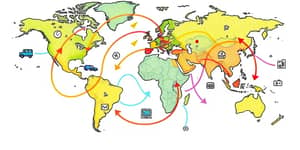
Global commodity markets have entered a period of unprecedented volatility, driven by a confluence of conflicts, trade disputes, and climatic disruptions. As 2025 unfolds, traders, investors, and policymakers are grappling with price swings that reflect deeper geopolitical fault lines and an evolving economic landscape. This article dives into the forces behind the rally, sector-specific impacts, practical strategies for market participants, and forward-looking considerations for navigating these turbulent times.
With intensifying geopolitical uncertainty worldwide, commodity markets are reacting to every new flashpoint—from renewed clashes between Israel and Hamas to fresh escalations along the Russia-Ukraine front. These conflicts threaten vital oil, gas, food, and fertilizer exports, rattling supply chains and spurring speculative flows.
Meanwhile, U.S.-China trade tensions persist, triggering tariffs on metals like steel and aluminum and disrupting agricultural trade. Asian-Pacific governments are aggressively securing critical minerals—such as gallium, magnesium, and natural graphite—to power next-generation technology and electric vehicles, amplifying competition for finite resources.
At the same time, climate- and weather-related shocks—from droughts in West Africa affecting cocoa to extreme heat waves impacting grain yields—have added a layer of unpredictability. The result is structurally higher commodity price volatility that can swing markets on any sign of upheaval.
Each commodity sector responds differently to geopolitical shocks, reflecting unique supply dynamics and demand drivers. The table below summarizes recent performance, core geopolitical influences, and critical considerations for market participants.
Crude oil markets remain highly sensitive to any escalation in the Middle East or fresh sanctions on Russia, despite OPEC+ holding elevated spare capacity. Natural gas in Europe faces chronic risk due to pipeline politics and seasonal demand, even as some nations accelerate renewable adoption.
Meanwhile, gold continues to draw central bank interest, with purchases doubling since 2022 and serving as a flight-to-quality investment in commodities. Cocoa’s historic 100% jump underscores how weather patterns and geopolitical tensions intersect to tighten agricultural supply chains.
In the face of heightened market uncertainty from conflicts, investors are seeking assets that can both hedge against inflation and mitigate sharp portfolio drawdowns. Historically, gold has proven its worth as a tactical hedge, while energy and selective industrial metals offer diversification benefits.
Recommended practical steps include:
By embracing strategic portfolio diversification in turbulent times, investors can reduce correlation with equities and bonds, capturing upside during commodity rallies while cushioning against sudden geopolitical shocks.
For long-term allocators, establishing systematic rebalancing rules—such as maintaining a fixed percentage in commodity ETFs—and stress-testing portfolios under various conflict scenarios can enhance resilience and clarity under pressure.
Global trade flows are realigning as nations pursue supply security. Efforts to diversify away from single-source dependencies—most notably reducing reliance on Chinese-controlled critical minerals—are reshaping import-export networks. New tariffs and countermeasures in the U.S.-China arena, along with proposed EU carbon border adjustments, have already sparked short-term rallies in steel and aluminum.
Meanwhile, regulatory changes tied to the energy transition are affecting fossil fuel demand. In Europe and North America, stricter emissions standards and incentives for renewables are channeling investment into green energy, while also creating transitional demand for natural gas as a bridge fuel.
With markets now expecting structurally higher price volatility, proactive risk management is essential. Key potential triggers for renewed spikes include:
Beyond these immediate threats, long-term demand growth in Asia-Pacific—driven by industrialization and clean-energy targets—will sustain pressure on critical resources. National stockpiling and strategic reserves for food, energy, and metals are becoming central to economic defense planning, reinforcing resilient supply chain strategies and sourcing.
Market participants should also keep an eye on central bank policies: potential U.S. Fed rate cuts may spur further gold demand, while a persistent strong dollar could temper overseas commodity purchases.
In an era defined by conflict, trade disputes, and climate uncertainty, commodity prices have emerged as both a barometer of global risk and a source of tactical opportunity. While sudden spikes can challenge short-term forecasts, they also open pathways for informed investors to hedge, diversify, and potentially profit.
By staying attuned to geopolitical developments, integrating hedge strategies tailored to volatile markets, and adopting robust risk-management frameworks, market participants can transform uncertainty into strategic advantage. The rally in commodities today underscores a timeless lesson: even amidst turmoil, disciplined and forward-looking approaches can yield stability and long-term growth.
References













